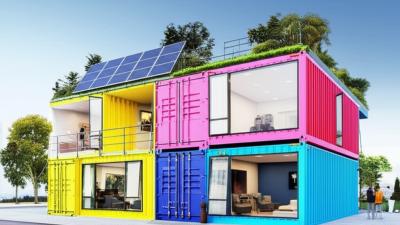News & Blogs
Innovative Uses of Sea Containers in Modern Sustainable Architecture
The innovative use of sea containers in modern sustainable architecture is transforming the landscape of construction and design, presenting a compelling solution to the pressing challenges of urbanization and resource scarcity. According to a report by the World Economic Forum, over 1.6 billion people are expected to live in urban areas by 2030, necessitating innovative building strategies that are both economical and environmentally friendly. Sea containers, initially designed for shipping goods, have emerged as a versatile and sustainable alternative for constructing residential and commercial spaces. Their modular nature allows for efficient stacking and rearrangement, promoting flexibility in design while minimizing waste.

In fact, the use of repurposed sea containers can reduce construction costs by up to 30% and lead to a 60% decrease in resource consumption, as noted by the International Green Building Council. This architectural trend not only addresses housing shortages but also aligns with global sustainability goals, making sea containers a pivotal element in the future of eco-friendly building practices.
Why Sea Containers are an Eco-Friendly Solution for Urban Housing
The rise of urbanization has led to an increasing need for sustainable housing solutions. Sea containers have emerged as an eco-friendly option for urban dwellings, primarily due to their modular design and building material efficiency. According to a 2022 report by the World Green Building Council, constructing homes from repurposed shipping containers can save up to 40% in carbon emissions compared to traditional building methods. This makes them not only a practical solution for housing shortages but also a viable strategy for reducing the environmental impact of urban living.
One key advantage of sea containers is their durability and resilience. Built to withstand harsh maritime conditions, these structures can be adapted into long-lasting housing solutions. The International Maritime Organization estimates that over 500,000 containers are lost at sea each year, highlighting a vast and underutilized resource for construction. While modulating designs may present challenges, innovative architects have successfully transformed containers into aesthetically pleasing and functional residences.
Tip: When considering a sea container home, pay close attention to insulation and ventilation to optimize comfort and energy efficiency.
Transforming urban spaces with these shipping container homes can also boost local economies. The cost-effectiveness of building with sea containers can result in reduced housing prices, making urban living more accessible. Furthermore, this approach encourages sustainable practices by promoting recycling and reducing waste in construction materials.
Tip: Collaborate with architects who specialize in container homes to maximize design opportunities and ensure compliance with local building regulations.
Why Modular Design in Sea Containers Enhances Space Efficiency
The use of sea containers in modern architecture has revolutionized the concept of space efficiency, particularly through modular design. According to a report by the Modular Building Institute, modular construction can reduce project timelines by up to 50% while minimizing waste by about 90%. This makes sea containers not only a sustainable option but also a cost-effective solution for urban development. Their standard dimensions allow for easy stacking and arrangement, permitting architects to maximize usable space creatively and efficiently.
Incorporating sea containers in building design also aligns with sustainability goals, as they are often recycled units. A study from the U.S. Green Building Council found that building with reusable materials can significantly reduce a project's carbon footprint. The adaptability of sea containers allows for innovative designs that can host residential, commercial, and even agricultural spaces, creating multifunctional environments within limited urban plots.
**Tips:** When planning a project with sea containers, consider the local zoning regulations and building codes, as these can impact the feasibility of your design. Additionally, exploring ways to incorporate green technologies, such as solar panels and rainwater harvesting systems, can further enhance the sustainability of your sea container project.
Innovative Uses of Sea Containers in Modern Sustainable Architecture
Why Incorporating Renewable Energy in Sea Container Structures is Essential
Incorporating renewable energy into sea container structures is essential for maximizing their sustainability and minimizing their environmental impact. Recent reports indicate that the construction industry is responsible for nearly 39% of global carbon emissions, with energy consumption from buildings accounting for a significant portion of this figure. By utilizing solar panels, wind turbines, and other renewable energy sources, container homes can significantly reduce reliance on fossil fuels, potentially cutting operational costs by up to 70% over time.
Tips: When designing a sea container structure, consider integrating solar panels on the roof to harness sunlight efficiently. This not only contributes to energy independence but can also enhance the aesthetic appeal of your architecture.
Moreover, energy-efficient practices such as extensive insulation and the use of energy-efficient windows can further decrease energy consumption. The U.S. Green Building Council emphasizes that buildings incorporating sustainable technologies can raise property values by 10% or more, making them not just eco-friendly but also economically viable investments.
Tips: Opt for high-performance insulation materials to improve thermal efficiency within your container, ensuring a comfortable living space while minimizing heating and cooling costs.
Why Sea Containers Foster Community Engagement in Sustainable Living
The innovative use of sea containers in sustainable architecture is not just about creating efficient living spaces; it also plays a crucial role in fostering community engagement. According to a 2021 report by the International Journal of Sustainable Architecture, projects utilizing repurposed shipping containers are more likely to promote social interaction among residents due to their unique designs, which encourage communal living and shared spaces. These structures often facilitate outdoor areas and communal gardens, promoting a sense of ownership and accountability within the community.
By integrating sea containers into urban environments, developers have the opportunity to address housing shortages while simultaneously creating platforms for community involvement. The same report indicates that projects leveraging container architecture can reduce construction costs by up to 30% compared to traditional methods, making them not only a cost-effective solution but also an avenue for local organizations to engage with residents. As neighborhoods embrace these innovative structures, they create spaces that invite collaboration, cultural exchange, and social responsibility, ultimately leading to stronger, more connected communities.
Why Adaptive Reuse of Shipping Containers Reduces Waste in Construction
The adaptive reuse of shipping containers in construction not only provides a cost-effective solution but also significantly reduces waste, aligning with sustainability goals. With the construction industry increasingly focused on minimizing its environmental impact, shipping containers offer a flexible and resource-efficient alternative. They can be repurposed into a variety of functional spaces, from homes to municipal facilities, effectively giving new life to materials that would otherwise contribute to landfill waste.
Tips for implementing shipping container architecture include prioritizing local sources for additional materials to further reduce waste and costs. Engaging with community stakeholders can also enhance the design process, fostering a sense of ownership and trust. As seen in various urban renewal projects across the U.S., such as those spearheaded by innovative architecture groups, transforming neglected areas using container architecture can breathe vitality into communities while promoting sustainable development.
By tapping into the circular economy principles, construction projects can fulfill low-carbon targets while making informed design decisions. Utilizing shipping containers can save both time and resources, allowing for rapid deployment of structures without compromising on quality or aesthetic appeal.
Related Posts
-

Mastering the Process: A Comprehensive Guide to Shipping a Container Efficiently
-

The Science Behind Refrigerated Containers and Their Role in Modern Logistics
-

Maximize Your Space with 20 Foot Storage Containers for Effective Organization Solutions
-

The Ultimate Guide to Efficient Storage for Shipping Containers and Optimization Tips
-

Maximizing Space with the Best 20 Storage Container Solutions for Every Home
 عربي
عربي عربي
عربي